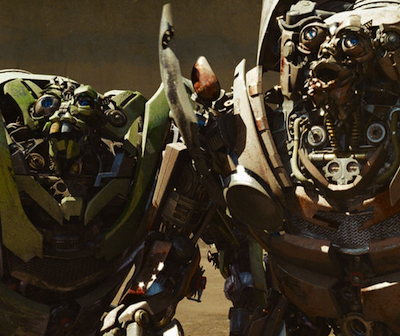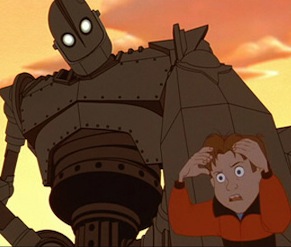Rarely do I believe a movie should be slapped with a “good” or “bad” label (it’s all a matter of taste and experience, really), but after being thoroughly annihilated by Transformers: Revenge of the Fallen in 2009, I had a realization: the movie was something toxic.
 Incoherent, incompetent and more than a little racist, I walked out of the Transformers sequel convinced it was not only one of the worst films I’d ever sat through, but a movie that was actually detrimental to anyone who saw it. The complete lack of storytelling effort, the hyper-sexualized Megan Fox, the caricatures of Earth’s many people (images of the deli employee with crooked teeth continue to haunt my memories) and endless gross-out humor (i.e. a robot with balls!)—this wasn’t just dumb fun. It felt destructive.
Incoherent, incompetent and more than a little racist, I walked out of the Transformers sequel convinced it was not only one of the worst films I’d ever sat through, but a movie that was actually detrimental to anyone who saw it. The complete lack of storytelling effort, the hyper-sexualized Megan Fox, the caricatures of Earth’s many people (images of the deli employee with crooked teeth continue to haunt my memories) and endless gross-out humor (i.e. a robot with balls!)—this wasn’t just dumb fun. It felt destructive.
In the end, the movie made $400 million at the box office. That worried me—how many innocent minds did this movie reach? What did they think of the movie!? On a quest to find out, I started talking to friends’ kids who had seen the movie. No surprise—most of them loved it. And why wouldn’t they? They’re the ones who play with toys and run around their houses pretending to be Optimus Prime, so when they see the giant alien robot duking it out in a bedlam of colors, sounds and explosions, it’s all those playtime fantasies come to life. The movie’s based on a Hasbro line, for Pete’s sake—this consideration made me wonder if I should drop my anxiety and let these young people have their fun.
But the feeling I got from Transformers 2 crept up again after catching an early screening of this weekend’s Real Steel, in a theater filled to the brim with children. Unlike Transformers: RotF, the new Hugh Jackman robot boxing movie isn’t mentally damaging, but it is plain silly. The movie loves (and owns) the fact that it’s premise could have been conceived by an eight-year-old in the middle of smashing robot action figures together with animated glee. No logic, just fun. After the movie, one little girl left exclaiming “I want a robot! I want a robot!” She was delighted.
 I don’t want to be the grumpy old film snob who begins every thought with “movies were so much better when I was a kid,” and I certainly don’t want to rain on the parade of any child who enjoys the heck out of a movie. But the blockbusters that aim for pure, sugar-high entertainment, the you-can’t-knock-it-because-it’s-for-kids movies like Real Steel make me wonder what kind of movies today’s youth will trek out to see when they grow up. The consensus I hear is that we don’t need material that challenges kids, because they’re kids.
I don’t want to be the grumpy old film snob who begins every thought with “movies were so much better when I was a kid,” and I certainly don’t want to rain on the parade of any child who enjoys the heck out of a movie. But the blockbusters that aim for pure, sugar-high entertainment, the you-can’t-knock-it-because-it’s-for-kids movies like Real Steel make me wonder what kind of movies today’s youth will trek out to see when they grow up. The consensus I hear is that we don’t need material that challenges kids, because they’re kids.
Steven Spielberg, a grandmaster of escapist cinema, is a producer on Real Steel, but there feels like a recognizable difference between a kids movie like E.T. and anything seeing release today. That movie doesn’t pander to children, but makes a point to see the world on their level, unfolding an evolving relationship between a boy and his alien. In Real Steel, the movie tells you to accept that the kid at the center of the film, Max, has found a friend in his non-sentient robot boxer. He finds joy and connects with his father because he clobbers robots with his keen video game skills.
One of my favorite movies of all time, the animated film The Iron Giant, bombed at the box office and I think it’s because the film didn’t seem like a “kids movie.” For most, animation is a medium for kids and, while I think The Iron Giant is movie kids should definitely see, it’s not content on telling a fluffy story and being forgotten after its 90 minute run time. The movie stirs young people to ask questions on violence and death, as opposed to, “Where can I get the toy version of that robot?!” The Iron Giant aims for less of a visceral connection and more of an intellectual one, and that’s not an easy sell for a sensory-first child.
 Real Steel is an expertly made film (and, heck, even Transformers 2 takes Michael Bay’s particular knack for action to pull off), but it’s not a cinematic effort that’s digging deep. It doesn’t try to do that, but more importantly, we’re not really asking it to. Occasionally, thoughtfulness and smart humor is tucked away inside premises that appear to fit this merchandise-born mold (I’m the guy who found resonance in The Smurfs), but it’s rare. Audiences have decided (with their money) that “kids movies” are at their best when they’re at their shallowest. The only way to really inspire change is not settling, but even I think it’s terrifying to tell a child “no.” They don’t wan to see The Iron Giant, they want to see Transformers 2!
Real Steel is an expertly made film (and, heck, even Transformers 2 takes Michael Bay’s particular knack for action to pull off), but it’s not a cinematic effort that’s digging deep. It doesn’t try to do that, but more importantly, we’re not really asking it to. Occasionally, thoughtfulness and smart humor is tucked away inside premises that appear to fit this merchandise-born mold (I’m the guy who found resonance in The Smurfs), but it’s rare. Audiences have decided (with their money) that “kids movies” are at their best when they’re at their shallowest. The only way to really inspire change is not settling, but even I think it’s terrifying to tell a child “no.” They don’t wan to see The Iron Giant, they want to see Transformers 2!
The “kids movie” moniker has taken on new meaning: good, clean, fun blockbusters. I think those movies are an important part of a movie-going diet, but like any junk food, they can be indulged upon and potentially dangerous. What’s the kids movie equivalent to celery sticks? We should start balancing our cinematic diets—we don’t want our young people to fill up on popcorn.
=”font-style:>



